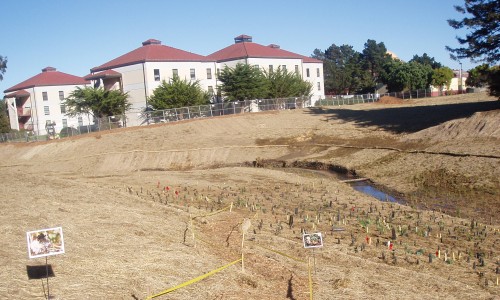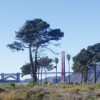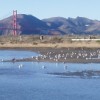 | | Ever wonder why
there are
walruses
peering out of a San Francisco building?
If not, why not?
If so, maybe you can satisfy your curiosity on a Shaping SF
Ecological History bike tour. |
 I first went on one of these tours in 2005 with ride leader
Chris Carlsson (of Shaping San Francisco and CounterPULSE),
Peter Brastow (of Nature in the City), and a good group of
bikers. Our tour started South of Market, an area shaped by
the mighty Hayes River (which you probably haven't seen, since
it's underground). We poked around there for a while, then
went to look at the walruses.
I first went on one of these tours in 2005 with ride leader
Chris Carlsson (of Shaping San Francisco and CounterPULSE),
Peter Brastow (of Nature in the City), and a good group of
bikers. Our tour started South of Market, an area shaped by
the mighty Hayes River (which you probably haven't seen, since
it's underground). We poked around there for a while, then
went to look at the walruses.
Later we spent a little time at Telegraph Hill. (If you
don't like climbing, take heart, we were at the foot of
Telegraph Hill!) Some recent ecological history there involved
some wild parrots that you may have read about or heard of.
 Less recent ecological history involved the hill being quarried
out from underneath where people were living. We
applauded Telegraph Hill citizens who stood firm to
protect their habitat.
Less recent ecological history involved the hill being quarried
out from underneath where people were living. We
applauded Telegraph Hill citizens who stood firm to
protect their habitat.
The photo on the left shows a quarried part of Telegraph Hill,
its erosion slowed down by a number of invasive, nonnative plants.
Not far away, nonnative parrots favor nonnative trees. There's
no shortage of considerations to keep in mind when you're dealing
with nature in the city!
 We biked along the city's north coastline (the pre-climate
change coastline, that is), with a typically-beautiful view
of the bay on our right. We
passed Alcatraz. When we got to Fort Mason, there
was a hill to climb, but don't worry, it's a gentle
climb. The Night Skate goes up there every week, and even
tourists manage it. Plus, it's the only place you can go
to get a good look at Black Point.
We biked along the city's north coastline (the pre-climate
change coastline, that is), with a typically-beautiful view
of the bay on our right. We
passed Alcatraz. When we got to Fort Mason, there
was a hill to climb, but don't worry, it's a gentle
climb. The Night Skate goes up there every week, and even
tourists manage it. Plus, it's the only place you can go
to get a good look at Black Point.
"What," I hear you cry, "is Black Point?"
| |
Named for the dark laurel trees growing nearby, Black Point
is the only remaining stretch of natural coastline in San
Francisco that's been left relatively unaltered by human
hands.

It's a little ways east of Black Point Battery, a Civil War
fortification.
| |

 We biked past
Crissy Field, though we would return to it, but first we
wanted to head to the heart of the Presidio, to a place called
Tennessee Hollow, because some folks were waiting for us there.
We biked past
Crissy Field, though we would return to it, but first we
wanted to head to the heart of the Presidio, to a place called
Tennessee Hollow, because some folks were waiting for us there.
Tennessee Hollow had a creek running through it, but
the military had diverted it into a culvert and used the
area as a landfill. There was a firing range nearby, so
clearing out the landfill meant dealing with lead and
other heavy metals. It was cleared out, though, the creek
was freed up, and folks are restoring the creekside with
native plants, as seen in the
photo on the right.
 We headed back down to Crissy Field, which is kind of the exact
opposite of Black Point, having been seriously altered by human
hands. Previous alterations have destroyed a lagoon there, so
the current effort to build a
restored lagoon has taken constant effort -- more
human hands, but constructive ones. Waterfowl have appreciated
the effort.
We headed back down to Crissy Field, which is kind of the exact
opposite of Black Point, having been seriously altered by human
hands. Previous alterations have destroyed a lagoon there, so
the current effort to build a
restored lagoon has taken constant effort -- more
human hands, but constructive ones. Waterfowl have appreciated
the effort.
|







